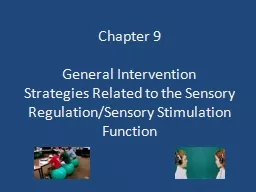

General Intervention Strategies Related to the Sensory RegulationSensory Stimulation Function When the function of challenging behavior is sensory regulationsensory stimulation the students challenging or appropriate behavior produces sensory input or it functions to regulate ie ID: 412144
Download Presentation The PPT/PDF document "Chapter 9" is the property of its rightful owner. Permission is granted to download and print the materials on this web site for personal, non-commercial use only, and to display it on your personal computer provided you do not modify the materials and that you retain all copyright notices contained in the materials. By downloading content from our website, you accept the terms of this agreement.
Slide1
Chapter 9General InterventionStrategies Related to the Sensory Regulation/Sensory Stimulation FunctionSlide2
When the function of challenging behavior is sensory regulation/sensory stimulation, the students’ challenging (or appropriate) behavior produces sensory input or it functions to regulate (i.e., increase or decrease) the level and type of sensory stimulation within the environment. Slide3
Stimulation may occur within each of the sensory systems:~ visual (sight)~ auditory (hearing)~ tactile (touch)
~ olfactory (smell)~ gustatory
(taste)~ vestibular (sense of movement and space)
~
proprioceptive
(sensation of muscles, tendons and joints)Slide4
It is useful to separate challenging behavior that is maintained by sensory-based outcomes as a third function. Often, the function produces an internal change that is not observable and is maintained by nonsocial, automatically reinforcing consequences.Slide5
Challenging behavior may occur when there is a mismatch between the type of level of stimulation required or needed by the student and the type or level currently available to them. Through the behavior, students attempt to obtain the optimal level of stimulation.Slide6
Behavioral examples of stereotypical needs for increased stimulation:~ hand mouthing/oral stimulations~ repetitive manipulation of objects~ self-injurious behavior
~ jumping/rocking/hand flappingSlide7
Behavioral examples of needs for decreased levels of stimulation:~ coverage of eyes/ears~ running from classroom~ direct aggression-to stop unwanted stimuli
~ direction refusalSlide8
Goals to be addressed:To provide an environment that increases or decreases sensory input or that matches the level of stimuli needed by the student.To assist students in regulating their level of stimulation to a workable level.To teach students appropriate ways to indicate they need a change in stimulation or that they do not like a particular form of sensory input.Slide9
GoalsTo teach students appropriate behaviors that will produce the type of desired stimulation.To increase, within limits, students’ ability to function in environments that do not provide optimal levels of stimulation.Slide10
Examples of sensory toolsSlide11
Sensory tools cont.